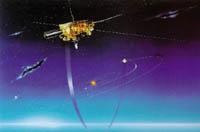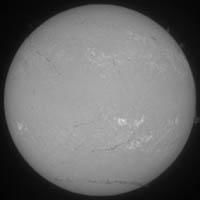The odyssey of Ulysses towards the Sun

Since the beginning of Humanity, all peoples of all races and colors that dwell and have lived on Earth have greeted the Sun. There is no life without light and no heat. However, times have changed and, although the romantic vision of the Sun is still alive, the scientific perspective is being imposed. The Sun is no longer known as spirit or god, but as a gigantic sphere full of gases and plasma that develop the nuclear fusion process.
Therefore, scientists seek mechanisms for the functioning and evolution of the Sun. The development of astronautics and observation systems has allowed to accumulate numerous data on the Sun. Undoubtedly, the most important steps in the Sun's observation journey have been made by probes sent to him.
First studies in Spain
Leaving the orbit of the Earth and approaching the Sun is not easy. The truth is that it is more difficult than approaching external planets. This is because, when approaching, the probes must stop instead of accelerating, to reduce their heliocentric orbit, rotating the Sun, and unify the speed of translation. For this, a lot of energy is needed. Until the development of high-powered rockets, it was not possible to approach the orbit of the Sun.
When overcoming the power problem, another major one emerged: As we approach the Sun, the temperature rises exponentially. Therefore, protective alloys had to be invented. The U.S. pioneer and the former spacecraft of the Soviet Union first set off towards the Sun, but they were far away in orbit, as the methods of propulsion were not the most adequate.
Subsequently, in 1974 and 1976 two probes were sent by Germany and NASA, called Helios. Using the Titan rocket at the time, the Helios-1 probe reached 48 million kilometers from the Sun, 238,000 kilometers per hour. While outside the rocket the temperature was 370ºC, inside there was 30ºC. The Helios-2 probe reached 45 million kilometers from the Sun, 3 million kilometers later, but the temperature increased by 10%. The data clearly indicates the exponential increase in temperature.

Until then the Sun was seen from the ecliptic orbit, that is, from a single plane. From then on, scientists proposed another intention, to see the Sun from other planes, the poles. In other words, the Sun would be looking above and below. As a result of this need, in 1978 the ISPM program was created and jointly led by ESA and NASA, at least initially.
Ulysses Ulysses
According to the project presented in 1981, two probes would be sent to the Sun, one European and one American, one on the Sun and one below, with the aim of obtaining information from both poles at a time. Due to budgetary problems, NASA retreated. However, it committed to some extent to the commitments acquired and NASA assumed the launch of the European probe.
After the changes in the project, ESA gave the project a new and, at the same time, mythical name of the traveler Ulysses. Despite the fact that the Ulysses of mythology was a quick trip, it cost this of the ESA to leave. Delays, the start date was set for May 1986. A few days before the launch of the Ulysses probe, the Challenger accident occurred. In view of this, the United States decided to change the Centaur launcher, so a new delay.
After a long standby, the 371 kilogram Ulysses probe was launched into space on 6 October 1990 at the Discovery ferry. It began with the aim of studying the magnetic fields of the Sun, the particles of the planets, the dust of the cosmos, the wind of the Sun... but seen from a completely different perspective.
Although the lens of the probe, called mythology, was the Sun, the probe went in the opposite direction towards Jupiter. Why? Despite its rapid evolution, the Ulysses probe could not ignore the ecliptic, the maximum circle of the Earth around the Sun. However, Jupiter, because of its force of attraction, was able to change the direction of the probe, as if it were a viguilla that would launch the probe to the poles of the Sun. Although the road was long, there was no other option to leave the ecliptic, so the probe departed like this.
After 1,000 million kilometers, the Ulysses probe approached in early 1992 to the areas of Jupiter. He walked over the atmosphere of the giant planet, about 378,000 kilometers, to change direction and leave the ecliptic by Jupiter influence, towards the South Pole of the Sun.

On June 26, 1994, it officially reached the South Pole of the Sun, 345 million kilometers away. Far, far away, but in a perspective until then unknown. Just over a year later, on July 31, 1995, the probe reached on the North Pole. The Ulysses probe collected a series of data on the solar magnetic field and the wind of the Sun, among which is the absence of magnetic poles, the uniformity and radiality of the magnetic fields of both poles the wind speed of the poles to the equator is halved, from 800 kilometers per second to 400.
New year 2000
After completing the orbit, the Ulysses probe has continued its path. A year ago I had traveled 3,800 million kilometers without problems, even though at some point I had made some small mistake.
In September next year he will return to the South Pole and complete his tour of the South Pole in January 2001, while in September will take place in the North Pole. On this occasion it is expected to obtain new data, since the situation of the Sun in the activity is different from that of 6 years ago. On this occasion they want to collect data on sunspots. Officially with this, the long journey of the Ulysses probe will be finished, perhaps not for duration, but far longer than that of that mythology Ulysses. Then begins the journey of scientists, who will have to spend a lot of time researching a lot of collected data.
Published in 7
Buletina
Bidali zure helbide elektronikoa eta jaso asteroko buletina zure sarrera-ontzian











